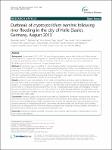Outbreak of cryptosporidium hominis following river flooding in the city of Halle (Saale), Germany, August 2013
Gertler, Maximilian
Dürr, Matthias
Renner, Peter
Poppert, Sven
Askar, Mona
Breidenbach, Janina
Frank, Christina
Preußel, Karina
Schielke, Anika
Werber, Dirk
Chalmers, Rachel
Robinson, Guy
Feuerpfeil, Irmgard
Tannich, Egbert
Gröger, Christine
Stark, Klaus
Wilking, Hendrik
Background: During weeks 32–33, 2013, 24 cases of cryptosporidiosis were notified in the city of Halle (annual mean 2008–2012: 9 cases). We investigated the outbreak to identify the source and recommend control measures, considering that between weeks 23–25 the river Saale which flows through the city centre overflowed the floodplain, parts of the city centre and damaged sewage systems. Methods: We defined a case as a resident of Halle with gastroenteritis, Cryptosporidium-positive stool and disease onset weeks 27 through 47. In a case–control study among kindergarten children, we compared cases and controls regarding environmental exposure, use of swimming pools, zoo visits and tap water consumption 14 days pre-onset or a corresponding 14-days-period (controls) and adjusted for residence. Stool specimens were tested by microscopy and PCR, and Cryptosporidium DNA was sequenced. Samples from public water system, swimming pools and river Saale were examined for Cryptosporidium oocysts (microscopy and PCR). Results: Overall, 167 cases were detected, 40/167 (24%) were classified as secondary cases. First disease onsets occurred during week 29, numbers peaked in week 34 and started to decrease in week 36. Median age was 8 years (range: 0–77). Compared to controls (n = 61), cases (n = 20) were more likely to report visits to previously flooded areas (OR: 4.9; 95%-CI: 1.4-18) and the zoo (OR: 2.6; 95%-CI: 0.9-7.6). In multivariable analysis visits to the floodplain remained the sole risk factor (OR: 5.5; 95%-CI: 1.4-22). Only C.hominis of a single genotype (IbA9G2) was detected in stools. Oocysts were detected in samples from the river, two local lakes and three public swimming pools by microscopy, but not in the public water supply. Conclusions: Evidence suggests that activities in the dried out floodplain led to infection among children. Secondary transmissions may be involved. Consequently, authorities recommended to avoid playing, swimming and having picnics in the flood-affected area. Health authorities should consider the potential health risks of long-term surviving parasites persisting on flooded grounds and in open waters even several weeks after the flooding and of bathing places close to sewage spill-overs. Preventive measures comprise water sampling (involving parasites), information of the public and prolonged closures of potentially contaminated sites.
Dateien zu dieser Publikation
Keine Lizenzangabe

